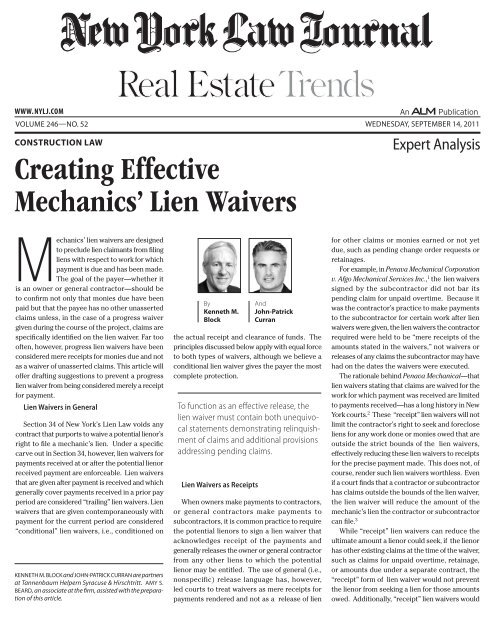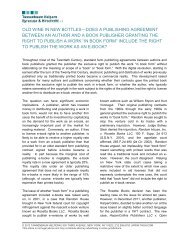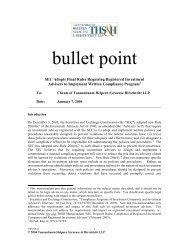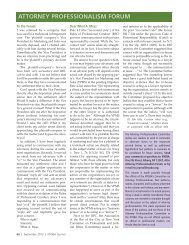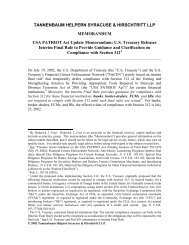Creating Effective Mechanics' Lien Waivers - Tannenbaum Helpern ...
Creating Effective Mechanics' Lien Waivers - Tannenbaum Helpern ...
Creating Effective Mechanics' Lien Waivers - Tannenbaum Helpern ...
- No tags were found...
Create successful ePaper yourself
Turn your PDF publications into a flip-book with our unique Google optimized e-Paper software.
www. NYLJ.comVolume 246—NO. 52 wednesday, september 14, 2011Construction law<strong>Creating</strong> <strong>Effective</strong>Mechanics’ <strong>Lien</strong> <strong>Waivers</strong>Expert AnalysisMechanics’ lien waivers are designedto preclude lien claimants from filingliens with respect to work for whichpayment is due and has been made.The goal of the payer—whether itis an owner or general contractor—should beto confirm not only that monies due have beenpaid but that the payee has no other unassertedclaims unless, in the case of a progress waivergiven during the course of the project, claims arespecifically identified on the lien waiver. Far toooften, however, progress lien waivers have beenconsidered mere receipts for monies due and notas a waiver of unasserted claims. This article willoffer drafting suggestions to prevent a progresslien waiver from being considered merely a receiptfor payment.<strong>Lien</strong> <strong>Waivers</strong> in GeneralSection 34 of New York’s <strong>Lien</strong> Law voids anycontract that purports to waive a potential lienor’sright to file a mechanic’s lien. Under a specificcarve out in Section 34, however, lien waivers forpayments received at or after the potential lienorreceived payment are enforceable. <strong>Lien</strong> waiversthat are given after payment is received and whichgenerally cover payments received in a prior payperiod are considered “trailing” lien waivers. <strong>Lien</strong>waivers that are given contemporaneously withpayment for the current period are considered“conditional” lien waivers, i.e., conditioned onKenneth M. Block and John-Patrick Curran are partnersat <strong>Tannenbaum</strong> <strong>Helpern</strong> Syracuse & Hirschtritt. Amy S.Beard, an associate at the firm, assisted with the preparationof this article.ByKenneth M.Blockthe actual receipt and clearance of funds. Theprinciples discussed below apply with equal forceto both types of waivers, although we believe aconditional lien waiver gives the payer the mostcomplete protection.<strong>Lien</strong> <strong>Waivers</strong> as ReceiptsAndJohn-PatrickCurranTo function as an effective release, thelien waiver must contain both unequivocalstatements demonstrating relinquishmentof claims and additional provisionsaddressing pending claims.When owners make payments to contractors,or general contractors make payments tosubcontractors, it is common practice to requirethe potential lienors to sign a lien waiver thatacknowledges receipt of the payments andgenerally releases the owner or general contractorfrom any other liens to which the potentiallienor may be entitled. The use of general (i.e.,nonspecific) release language has, however,led courts to treat waivers as mere receipts forpayments rendered and not as a release of lienfor other claims or monies earned or not yetdue, such as pending change order requests orretainages.For example, in Penava Mechanical Corporationv. Afgo Mechanical Services Inc., 1 the lien waiverssigned by the subcontractor did not bar itspending claim for unpaid overtime. Because itwas the contractor’s practice to make paymentsto the subcontractor for certain work after lienwaivers were given, the lien waivers the contractorrequired were held to be “mere receipts of theamounts stated in the waivers,” not waivers orreleases of any claims the subcontractor may havehad on the dates the waivers were executed.The rationale behind Penava Mechanical—thatlien waivers stating that claims are waived for thework for which payment was received are limitedto payments received—has a long history in NewYork courts. 2 These “receipt” lien waivers will notlimit the contractor’s right to seek and forecloseliens for any work done or monies owed that areoutside the strict bounds of the lien waivers,effectively reducing these lien waivers to receiptsfor the precise payment made. This does not, ofcourse, render such lien waivers worthless. Evenif a court finds that a contractor or subcontractorhas claims outside the bounds of the lien waiver,the lien waiver will reduce the amount of themechanic’s lien the contractor or subcontractorcan file. 3While “receipt” lien waivers can reduce theultimate amount a lienor could seek, if the lienorhas other existing claims at the time of the waiver,such as claims for unpaid overtime, retainage,or amounts due under a separate contract, the“receipt” form of lien waiver would not preventthe lienor from seeking a lien for those amountsowed. Additionally, “receipt” lien waivers would
wednesday, september 14, 2011not limit a contractor’s ability to recover amountsowed through a quantum meruit claim. 4Courts also have recognized that lien waiverspresent a problem for contractors becausethe timing of payment often lags well behindcompletion of work, but payment may not bemade unless the lien waivers are executed. InUnited States ex. rel. F&G Mech. Corp. v. ManshulConst. Corp., 5 the court found that where thecontractor executed a lien waiver acknowledgingthat no other sums were due but that the parties’course of dealing demonstrated that the waiversfunctioned only as receipts for the payments made,the lien waiver did not release claims for otheramounts owed for work the subcontractor hadperformed and was deemed a mere receipt.Crafting <strong>Effective</strong> <strong>Waivers</strong>Owners and general contractors seeking to uselien waivers to limit mechanics’ liens and otherclaims for payment have a fine line to walk. Ifthe lien waiver is too broad, it will run afoul ofSection 34, but if it is too narrow, it will protectthe owner or contractor from mechanic’s liensonly as to the amount stated in the “receipt”lien waiver. Owners and general contractorscan consider using lien waivers which are morecomparable to releases than receipts. Ownersand general contractors should carefully considerthe language in a “release” lien waiver in order toensure themselves the greatest protection frommechanic’s liens while still avoiding vacatur ofthe waiver under Section 34.In order for a lien waiver to function as a releaserather than as a receipt for payment, the waivermust include specific language waiving or releasingclaims and provide the lienor the opportunity topreserve pending and otherwise timely claimswhich may not have yet been the subject of anapplication for payment. The intent to waive aright, such as the right to enforce a mechanics’lien, must be unmistakably manifested on theface of the lien waiver before the waiver can beenforced against the potential lienor. 6To avoid these problems, a lien waiver andrelease should not be limited to a simple recital ofamounts paid and should not contain boilerplatelanguage, such as the party performing the work“represents that it has no claims against [thecontractor or owner] to the date of this requisitionand hereby waives and releases any and all claims,obligations, costs, expenses, causes of action andliens on the premises and/or the improvementthereon.” 7 Courts tend to consider such languageindicative of receipt lien waivers, especially if theparties’ course of dealing provides evidence thatthe parties, too, considered the waivers merereceipts.To function as an effective release, the lienwaiver must contain both unequivocal statementsdemonstrating relinquishment of claims andadditional provisions addressing pendingclaims. Language that a recital of paymentsmade “does not include material furnished, laborperformed, or expense incurred for which writtenauthorization has not been given,” accompaniedby space or schedule to be attached for thepotential lienor to list the additional work ormaterials for which payment had not yet beenrendered, has been found enforceable as a releaseagainst the potential lienor with regard to claimsnot listed. 8This kind of disclaimer, placed above thecertification that the lien waiver is a true statementof account and releases “any claim or claims ofwhatever nature for materials furnished, laborperformed, or expense incurred to date whichis not included in the above amounts or notedin the space above as provided therefore” willmanifest the potential lienor’s unequivocal assentto releasing claims not specified. 9 Additionally,and in order to avoid the revival of stale claims,language should be included in the lien waiverthat notice of the “listed claims” has been timelyprovided in accordance with the terms of thecontract.While not related to the issue of the waiverof claims, the waiver should also contain arepresentation from the contractor that it has paidfor all labor, materials and equipment containedin its current application for payment or will doso upon receipt of the funds covered by the lienwaiver.ConclusionIn order for a lien waiver to function as awaiver of pending claims and not a mere receiptof payment, owners and contractors must draftthe lien waiver carefully by reciting paymentsmade and listing work and materials for whichpayment has not yet been made, and releasingall claims for work and materials other than theitems listed. Such language will demonstrate theintent to release claims and thus be enforced as arelease and not a mere receipt for payment.••••••••••••• • •• •••••••••••••1. 71 A.D.3d 493, 896 N.Y.S.2d 349 (1st Dept. 2010).2. See Tager v. Healy Avenue Realty Corp., 14 A.D.2d 584(2d Dept. 1961) (reducing mechanic’s lien by the amountowed under original contract because contractor had signedenforceable lien waiver for work performed under thatcontract, but foreclosing mechanic’s lien for amounts owedunder supplemental contracts for which no lien waivers wereexecuted).3. See Tager, supra at n.2.4. MCK Bldg. Assocs. Inc. v. St. Lawrence Univ.,301 A.D.2d 726, 754 N.Y.S.2d 397 (3d Dept. 2003).5. No. 94 CV 2436 CLP, 1998 WL 849327 (E.D.N.Y. Oct. 1,1998).6. See Orange Steel Erectors Inc. v. Newburgh Steel Prods. Inc.,225 A.D.2d 1010, 1012 (3d Dept. 1996) (lien waivers manifestedintent to relinquish claims on land and buildings, but did notwaive right to bring an action for additional amounts owed).7. F&G Mech.Corp., 1998 WL 849327, at *8.8. Kay-R Elec. Corp. v. Stone & Webster Const. Co., 23 F.3d 55,57-58 (2d Cir.1994).9. Kay-R Elec., supra at n. 8.Reprinted with permission from the September 14, 2011 edition of the NEW YORK LAWJOURNAL © 2011 ALM Media Properties, LLC. All rights reserved. Further duplicationwithout permission is prohibited. For information, contact 877-257-3382 or reprints@alm.com. # 070-09-11-22


